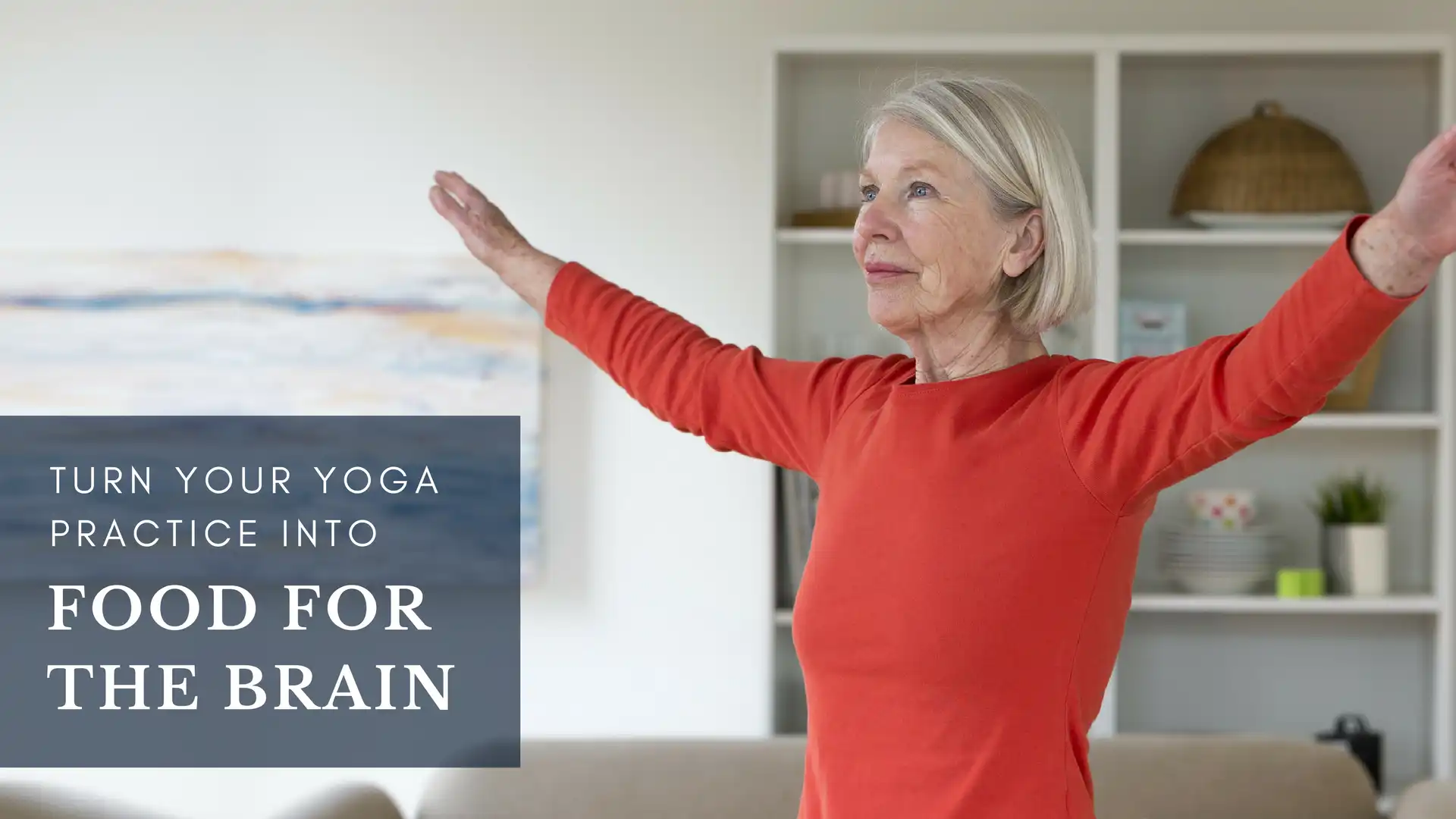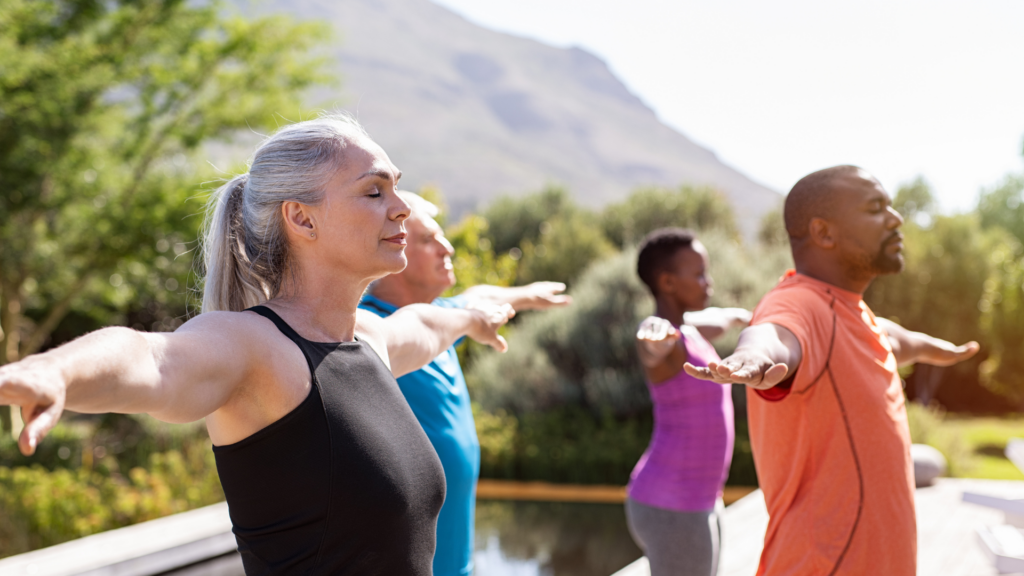Turn Your Yoga Practice into Food for the Brain

We’ve all experienced moments of “foggy brain,” forgetting where we put our keys or spacing out an appointment now and then. For some people, these brain lapses become significant and severe enough to warrant a clinical diagnosis—mild cognitive impairment (MCI). How can yoga help? Among other effects, the meditative aspects may actually help restore some brain functioning that has been lost.
Though the hard science is still inconclusive, in yoga practice, we can experience how healing and empowering the body can also help to heal and empower the mind and spirit. While MCI can occur at any age, it is most prevalent as a precursor to dementia in older adults. The Mayo Clinic reports that 4 in 10 individuals over 85 exhibit diagnosable symptoms of this condition.
More men than women are diagnosed with MCI. Some researchers believe that this may be because women more quickly progress to more severe dementia. In both men and women, the condition leads to “difficulty remembering recent events and/or new information, as well as problems with language, thinking, or judgment,” reports the Mayo Clinic. MCI is understood as a precursor to dementia, but not all who experience MCI will develop dementia.
Yoga As Brain Food

How can yoga help? It can spur the brain’s ability to morph, grow, and heal throughout the lifespan (and not only in childhood, adolescence, and young adulthood). This happens through neuroplasticity, the brain’s ability to reorganize itself by forming new neural connections. Meditation leads one to focus on one object, idea, sound, or linguistic phrase (sometimes a mantra, a simple repeated statement), and to coax focus back when it might wander elsewhere. When practiced mindfully, this can also very well be true of asana (posture practice) and pranayama (breathwork).
Research on Yoga and Cognitive Function
These practices can literally help reorganize or even grow parts of the brain. That can mean a brain that functions better, or functions more as it used to if functionality has faded. A study from the Hospital Israelita Albert (Sao Paolo, Brazil), for example, found that women over 50 years of age who regularly practice yoga have thicker brain matter than those who don’t.
Some researchers called into question the validity of the results because other life factors could have influenced the thickness of brain matter in the two groups. The study’s lead author, Elisa Kozasa, conceded as much. Yet Helen Lavretsky, of the UCLA Geffen School of Medicine—who is unaffiliated with the study in question—asserted that it contributes to a growing body of knowledge on yoga and neuroplasticity.
Lavretsky hypothesized that one factor could be that yoga helps reduce daily stress and thus frees the brain to better function and adapt. Kozasa conjectured that the mental “fitness” aspects of yoga, beyond the physical—including honing on particular aspects of poses, remembering names and sequences, and staying focused overall—could be another factor. Another study investigated the effects on brain functioning of meditative Kundalini yoga as compared to memory enhancement training, a more conventional MCI intervention.
It found that those who received both treatments experienced improvements in memory. The Kundalini meditation group, however, showed greater improvements in executive functioning and feelings of resilience, as well as reductions in signs of depression. The study authors conceded that this should be “confirmed in future clinical trials of yoga intervention for treatment and prevention of cognitive decline.”
What may also be true, though in need of scientific validation, is that these multiple effects can occur because yoga is a complex and holistic science of wellness, addressing many aspects of human functioning. This contrasts with Westernized intervention, created for a single purpose, however effective, validated, and healing for that purpose it may be. The yogic model posits that malfunctioning of one aspect of the human system will affect others, so those aspects are best treated along with any primary concern.
Mayo Clinic Includes Yoga in its Brain Training Program
In this holistic outlook, a memory treatment program from the Mayo Clinic, Healthy Action to Benefit Independence & Thinking (HABIT®), includes yoga. Results of this treatment program demonstrate that yoga might actually be more helpful for caregivers (who also partake in the program) than for the patients in question. The practice can greatly help them to ease stress, replenish energy and feelings of hope, and take care of their bodies. Greater wellness for caregivers can lead to better care for those undergoing brain and/or memory disorders, as well as—just as important—a better quality of life for them.
How to Diagnose MCI and Find Movement-Based Treatment
If you are one of those caregivers or someone noticing signs of MCI within yourself and are interested in yoga as a potential treatment, where should you start? First, obtain a professional consultation to find out if there is a formal diagnosis and to get clearance to begin yoga practice—always an important step when starting a new fitness or movement program.
Some assisted living and memory care centers offer yoga. If the person in question is not in such a program, many yoga studios, and even fitness centers, offer “gentle yoga” and “slow flow” classes. If the person is in the physical condition for “all levels”-type Vinyasa classes, that’s certainly an option, again, with the clearance of a doctor. As the described studies demonstrate, meditation practice might be just as important—if not more so—than asana (posture) practice. Once practice is established, one can just keep coming back to the mat and/or meditation cushion and watch the effects of practice unfold.
Resource:
https://www.igi-global.com/gateway/chapter/299505
Kathryn Boland is an RCYT and R-DMT (Registered Dance/Movement Therapist). She is originally from Rhode Island, attended George Washington University (Washington, DC) for an undergraduate degree in Dance (where she first encountered yoga), and at Lesley University for an MA in Clinical Mental Health Counseling, Expressive Therapies: Dance/Movement Therapy. She has taught yoga to diverse populations in varied locations. As a dancer, she has always loved to keep moving and flowing in practicing more active Vinyasa-style forms. Her interests have recently evolved to include Yin and therapeutic yoga, and aligning those forms with Laban Movement Analysis to serve the needs of various groups (such as Alzheimer’s Disease patients, children diagnosed with ADHD, and PTSD-afflicted veterans – all of which are demographically expanding). She believes in finding the opportunity within every adversity and doing all that she can to help others live with a bit more breath and flow!



